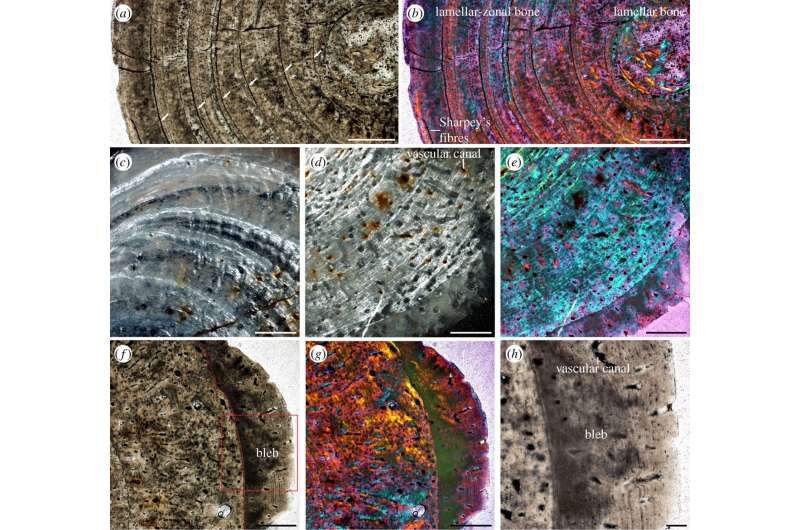June 6, 2018 report
Evidence of TB-like infection found in 245-million-year-old marine reptile

A team of researchers from Poland and the U.S. has found possible evidence of tuberculosis in a 245-million-year-old marine reptile. In their paper published in the journal Royal Society Open Science, the group describes their study of the fossilized remains of a Proneusticosaurus silesiacus specimen and why they believe the creature had a TB-like disease.
TB is an infection caused by the virus Mycobacterium tuberculosis. It mainly infects the lungs, but can on occasion infect other body parts such as the spine, brain or kidneys. It is also known for causing anomalies to appear on the ribs of people with infected lungs. Such anomalies generally take the form of blebs, or small bumpy protrusions.
The researchers were studying a specimen uncovered at the Gogolin quarry, a dig site on the border between Poland and the Czech Republic, over a century ago. Prior research had shown it to be a member of the sauropterygian family—they were aquatic reptiles that lived during the Mesozoic. The specimen under study had a long neck, flat skull and long, rounded teeth. But it was the creature's rib bones that caught the attention of the researchers—they had blebs very similar to those seen in modern creatures infected with TB.
Intrigued by their find, the researchers immediately began searching for all possible causes of the bumps, such as fractures, scurvy, fungal infections or even cancer. But one by one, each was ruled out, leaving TB as the likely cause. In their paper, the researchers also suggest the bumps may have been caused by pneumonia, which, they note, can be caused by TB. They note also that Proneusticosaurus have been referred to as the seal of ancient times, and coincidentally or not, modern seals are the marine animals that are most susceptible to TB infections.
The finding pushes back the date of the first evidence of TB by quite a long stretch—prior to this discovery, the record holder was a marsupial from 3 million years ago. The researchers acknowledge that they have no way to verify their findings, but suggest the rib bumps offer reasonably strong evidence of TB.
More information: Dawid Surmik et al. Tuberculosis-like respiratory infection in 245-million-year-old marine reptile suggested by bone pathologies, Royal Society Open Science (2018). DOI: 10.1098/rsos.180225
Abstract
An absence of ancient archaeological and palaeontological evidence of pneumonia contrasts with its recognition in the more recent archaeological record. We document an apparent infection-mediated periosteal reaction affecting the dorsal ribs in a Middle Triassic eosauropterygian historically referred to as 'Proneusticosaurus' silesiacus. High-resolution X-ray microtomography and histological studies of the pathologically altered ribs revealed the presence of a continuous solid periosteal reaction with multiple superficial blebs (protrusions) on the visceral surfaces of several ribs. Increased vascularization and uneven lines of arrested growth document that the pathology was the result of a multi-seasonal disease. While visceral surface localization of this periosteal reaction represents the earliest identified evidence for pneumonia, the blebs may have an additional implication: they have only been previously recognized in humans with tuberculosis (TB). Along with this diagnosis is the presence of focal vertebral erosions, parsimoniously compared to vertebral manifestation of TB in humans.
Journal information: Royal Society Open Science
© 2018 Phys.org





















